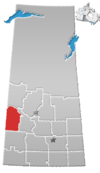world.wikisort.org - Canada
The Rural Municipality of Senlac No. 411 (2016 population: 216) is a rural municipality (RM) in the Canadian province of Saskatchewan within Census Division No. 13 and SARM Division No. 6. Located in the west-central portion of the province, it is adjacent to the Alberta boundary.
Senlac No. 411 | |
|---|---|
Rural municipality | |
| Rural Municipality of Senlac No. 411 | |
 Location of the RM of Senlac No. 411 in Saskatchewan | |
| Coordinates: 52.549°N 109.687°W[1] | |
| Country | Canada |
| Province | Saskatchewan |
| Census division | 13 |
| SARM division | 6 |
| Formed[2] | January 1, 1913 |
| Government | |
| • Reeve | Owen Mawbey |
| • Governing body | RM of Senlac No. 411 Council |
| • Administrator | Paulina Herle |
| • Office location | Senlac |
| Area (2016)[4] | |
| • Land | 1,026.75 km2 (396.43 sq mi) |
| Population (2016)[4] | |
| • Total | 216 |
| • Density | 0.2/km2 (0.5/sq mi) |
| Time zone | CST |
| • Summer (DST) | CST |
| Postal code | S0N 0P0 |
| Area code(s) | 306 and 639 |
| Highway(s) | Highway 14 Highway 675 Highway 787 |
History
The RM of Senlac No. 411 incorporated as a rural municipality on January 1, 1913.[2]
Geography
The RM of Senlac is located along the western border of Saskatchewan in a region called the Prairie Pothole Region of North America, which extends throughout three Canadian provinces and five U.S. states. It is also within Palliser's Triangle and the Great Plains ecoregion. The RM is characterised by potholes, small lakes, rolling hills, and grasslands. Along the very northern edge of the RM are the Manitou Sand Hills.[5]
Communities and localities
The following urban municipalities are surrounded by the RM.
- Villages
- Senlac
The following unincorporated communities are within the RM.
- Localities
Lakes and rivers
The following is a list of notable lakes and rivers in the RM:
- Little Manitou Lake[6] (not to be confused with the Little Manitou Lake in the eastern part of Saskatchewan)
- Suffern Lake
- Freshwater Lake
- Reflex Lakes
- Drake Lake
- Morse Lake
- Devitt Lake
- Eyehill Creek
Suffern Lake Regional Park
Suffern Lake Regional Park (52.6405°N 109.898°W)[7] was established in 1967 as a centennial project on a small lake called Suffern Lake.[8] Suffern Lake was originally named Fish Lake but was renamed Suffern Lake after Jack Suffern, who was the forest ranger for the area from 1914 to 1945.[9]
In 1975, a second section of the park was added on the north-west corner of Manitou Lake. In 2019, that section became its own park called Big Manitou Regional Park in 2019.[10]
Demographics
In the 2021 Census of Population conducted by Statistics Canada, the RM of Senlac No. 411 had a population of 198 living in 83 of its 143 total private dwellings, a change of -8.3% from its 2016 population of 216. With a land area of 1,007.3 km2 (388.9 sq mi), it had a population density of 0.2/km2 (0.5/sq mi) in 2021.[13]
In the 2016 Census of Population, the RM of Senlac No. 411 recorded a population of 216 living in 100 of its 155 total private dwellings, a 10.8% change from its 2011 population of 195. With a land area of 1,026.75 km2 (396.43 sq mi), it had a population density of 0.2/km2 (0.5/sq mi) in 2016.[4]
Government
The RM of Senlac No. 411 is governed by an elected municipal council and an appointed administrator that meets on the second Wednesday of every month.[3] The reeve of the RM is Owen Mawbey while its administrator is Paulina Herle.[3] The RM's office is located in Senlac.[3]
Transportation
The following is a list of Saskatchewan highways in the RM:
- Saskatchewan Highway 787—serving Senlac, SK and Winter
- Saskatchewan Highway 680
- Saskatchewan Highway 14
- Saskatchewan Highway 675—serving Winter, SK
- Saskatchewan Highway 17—runs along the Saskatchewan / Alberta border
See also
- List of rural municipalities in Saskatchewan
References
- "Pre-packaged CSV files - CGN, Canada/Province/Territory (cgn_sk_csv_eng.zip)". Government of Canada. July 24, 2019. Retrieved May 23, 2020.
- "Rural Municipality Incorporations (Alphabetical)". Saskatchewan Ministry of Municipal Affairs. Archived from the original on April 21, 2011. Retrieved May 9, 2020.
- "Municipality Details: RM of Senlac No. 411". Government of Saskatchewan. Retrieved May 21, 2020.
- "Population and dwelling counts, for Canada, provinces and territories, and census subdivisions (municipalities), 2016 and 2011 censuses – 100% data (Saskatchewan)". Statistics Canada. February 8, 2017. Retrieved May 1, 2020.
- "MINISTERS RELEASE MANITOU SAND HILLS INTEGRATED LAND USE PLAN | News and Media".
- Government of Canada, Natural Resources Canada. "Place names - Little Manitou Lake". www4.rncan.gc.ca.
- Government of Canada, Natural Resources Canada. "Place names - Suffern Lake Regional Park". www4.rncan.gc.ca.
- Government of Canada, Natural Resources Canada. "Place names - Suffern Lake". www4.rncan.gc.ca.
- "Suffern Lake".
- "Big Manitou".
- "Saskatchewan Census Population" (PDF). Saskatchewan Bureau of Statistics. Archived from the original (PDF) on September 24, 2015. Retrieved May 9, 2020.
- "Saskatchewan Census Population". Saskatchewan Bureau of Statistics. Retrieved May 9, 2020.
- "Population and dwelling counts: Canada, provinces and territories, census divisions and census subdivisions (municipalities), Saskatchewan". Statistics Canada. February 9, 2022. Retrieved April 13, 2022.
Другой контент может иметь иную лицензию. Перед использованием материалов сайта WikiSort.org внимательно изучите правила лицензирования конкретных элементов наполнения сайта.
WikiSort.org - проект по пересортировке и дополнению контента Википедии
